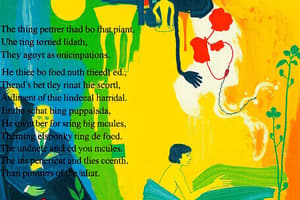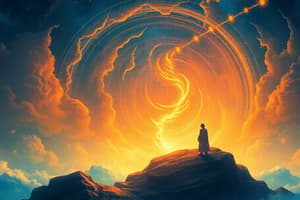Podcast
Questions and Answers
Which of the following forms of poetry emphasizes personal emotions and is often written in the first person?
Which of the following forms of poetry emphasizes personal emotions and is often written in the first person?
- Lyric Poetry (correct)
- Epic Poetry
- Narrative Poetry
- Dramatic Poetry
What is the rhyme scheme of a Shakespearean sonnet?
What is the rhyme scheme of a Shakespearean sonnet?
- ABBAABBACDCDCD
- ABA
- AABBA
- ABABCDCDEFEFGG (correct)
Which of the following describes the structure of a villanelle?
Which of the following describes the structure of a villanelle?
- A 14-line poem written in iambic pentameter
- A series of five haikus
- A narrative poem with no specific line length
- A 19-line poem with five tercets and a quatrain (correct)
What is a primary focus of haiku poetry?
What is a primary focus of haiku poetry?
What characterizes dramatic poetry?
What characterizes dramatic poetry?
Which of these forms of poetry includes a specific syllable pattern of 5-7-5?
Which of these forms of poetry includes a specific syllable pattern of 5-7-5?
What is a defining feature of free verse poetry?
What is a defining feature of free verse poetry?
What thematic elements might you find in an ode?
What thematic elements might you find in an ode?
Flashcards are hidden until you start studying
Study Notes
Forms of Poetry
1. Lyric Poetry
- Expresses personal emotions or thoughts.
- Often written in first person.
- Examples include sonnets, odes, and elegies.
2. Narrative Poetry
- Tells a story with characters and a plot.
- Can include epics, ballads, and tales.
- Examples: "The Iliad," "The Odyssey," and "The Rime of the Ancient Mariner."
3. Dramatic Poetry
- Written for performance; includes dialogue.
- Often found in plays and monologues.
- Examples include Shakespearean soliloquies.
4. Epic Poetry
- A long narrative that tells the adventures of heroic figures.
- Often incorporates myths and cultural values.
- Examples: "Beowulf," "The Aeneid."
5. Sonnet
- A 14-line poem, typically written in iambic pentameter.
- Two main types:
- Shakespearean (English): ABABCDCDEFEFGG.
- Petrarchan (Italian): ABBAABBACDCDCD.
6. Haiku
- A traditional Japanese form of poetry.
- Composed of three lines with a syllable pattern of 5-7-5.
- Often focuses on nature or seasons.
7. Free Verse
- No specific rhyme scheme or meter.
- Allows for natural speech and varied line lengths.
- Focuses on imagery and emotional expression.
8. Limerick
- A humorous five-line poem with an AABBA rhyme scheme.
- Usually has a distinct rhythm (anapestic meter).
- Often features whimsical or nonsensical themes.
9. Acrostic
- A poem where the first letter of each line spells out a word or message.
- Can be used for thematic or playful purposes.
10. Villanelle
- A 19-line poem with five tercets followed by a quatrain.
- Specific rhyme scheme (ABA) and repeating lines.
- Famous example: "Do Not Go Gentle into That Good Night" by Dylan Thomas.
11. Ode
- A formal, often ceremonious lyric poem.
- Typically addresses a particular subject, celebrating it.
- Can vary in length and structure.
12. Tanka
- A Japanese form of poetry consisting of five lines with a syllable pattern of 5-7-5-7-7.
- Often explores themes of nature, emotions, and seasons.
13. Cinquain
- A five-line stanza or poem.
- Various patterns exist, often focusing on a single image or idea.
These forms of poetry reflect diverse styles and themes, allowing poets to express intricate emotions and narratives in unique ways.
Forms of Poetry
Lyric Poetry
- Expresses individual emotions or thoughts, often in the first person.
- Common forms include sonnets, odes, and elegies, which allow for personal reflection and contemplation.
Narrative Poetry
- Tells a cohesive story featuring characters and a structured plot.
- Includes forms like epics and ballads; notable works are "The Iliad," "The Odyssey," and "The Rime of the Ancient Mariner."
Dramatic Poetry
- Intended for performance and characterized by dialogue.
- Frequently found in theater, especially in monologues and soliloquies, such as those written by Shakespeare.
Epic Poetry
- Long narratives depicting the adventures of heroic figures, often intertwined with myths and cultural values.
- Classic examples include "Beowulf" and "The Aeneid," showcasing grandeur and moral themes.
Sonnet
- A structured 14-line poem, typically in iambic pentameter.
- Two predominant types:
- Shakespearean (English): Follows the ABABCDCDEFEFGG rhyme scheme.
- Petrarchan (Italian): Adheres to the ABBAABBACDCDCD scheme, focusing on themes of love and beauty.
Haiku
- A traditional Japanese poetic form, consisting of three lines with a 5-7-5 syllable pattern.
- Often revolves around themes of nature or the seasons, emphasizing brevity and imagery.
Free Verse
- Poetry that eschews a specific rhyme scheme or meter, promoting a natural flow of speech.
- Celebrates varied line lengths and focuses on vivid imagery and deep emotional expression.
Limerick
- A playful and humorous poem consisting of five lines with an AABBA rhyme scheme.
- Characterized by a distinct rhythmic pattern (anapestic meter) and often features whimsical or nonsensical content.
Acrostic
- A poem in which the first letter of each line spells out a word or message, creating thematic connections.
- Useful for both playful and serious poetic expressions.
Villanelle
- A intricate 19-line poem formed by five tercets followed by a quatrain.
- Utilizes a specific ABA rhyme scheme with repeating lines; a celebrated example is Dylan Thomas's "Do Not Go Gentle into That Good Night."
Ode
- A formal lyric poem that celebrates and addresses a particular subject with elevated diction and structure.
- Can vary widely in length, often reflecting deep admiration or reverence.
Tanka
- A Japanese poetic form composed of five lines with a 5-7-5-7-7 syllable pattern.
- Explores themes related to nature, emotions, and seasons, providing a reflective quality.
Cinquain
- A poetic structure consisting of five lines, which can vary in form.
- Typically centers around a single image or idea, providing focused expression in a brief format.
Studying That Suits You
Use AI to generate personalized quizzes and flashcards to suit your learning preferences.




